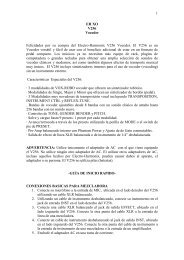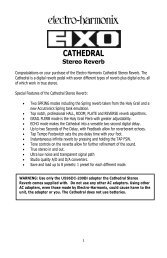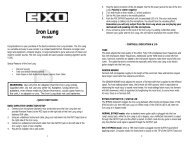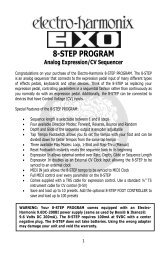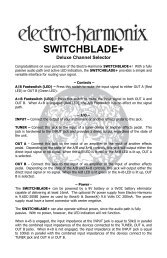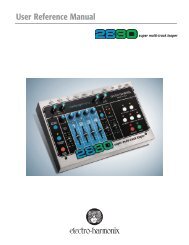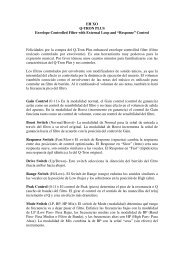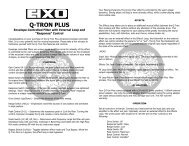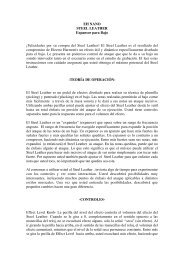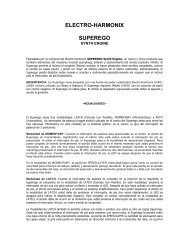Instructions (PDF) - Electro-Harmonix
Instructions (PDF) - Electro-Harmonix
Instructions (PDF) - Electro-Harmonix
Create successful ePaper yourself
Turn your PDF publications into a flip-book with our unique Google optimized e-Paper software.
- QUICK START GUIDE -BASIC MIXER CONNECTION SETUP1. Connect your microphone to the MIC input on the right side of the V256 using abalanced XLR cable.2. Using an unbalanced instrument cable, plug your instrument into the INST Input Jack onthe right side of the V256.3. Connect a balanced XLR cable to the EFFECT output jack on the left side of the V256.Connect the other end of the XLR cable to the line input of a mixer.4. Connect an unbalanced instrument cable from the INST output jack on the left side ofthe V256. Connect the other end of the instrument cable to the instrument input of amixer, or the input of an amplifier.5. Plug the AC Adapter into a wall outlet.6. Plug the barrel connector of the AC Adapter into the 9V power jack at the top of theV256. Polarity is center negative.7. If using a condenser microphone, flip the Phantom Power switch up to the top position,otherwise leave it off. The Phantom Power switch is located on the right side of theV256, next to the XLR MIC input.8. Push the MIC BYPASS footswitch until its associated LED is OFF. Sing into themicrophone, you will hear your dry vocal at this point. Adjust mixer settings as well asthe MIC GAIN switch on the V256 to obtain optimal mic levels.BASIC AMPLIFIER CONNECTION SETUP1. Connect your microphone to the MIC input on the right side of the V256 using abalanced XLR cable.2. Using an unbalanced instrument cable, plug your instrument into the INST Input Jack onthe right side of the V256.3. Connect an unbalanced instrument cable from the INST output jack on the left side ofthe V256. Connect the other end of the instrument cable to the input of a guitar, bass,or keyboard amplifier.4. Plug the AC Adapter into a wall outlet.5. Plug the barrel connector of the AC Adapter into the 9V power jack at the top of theV256. Polarity is center negative.6. If using a condenser microphone, flip the Phantom Power switch up to the top position,otherwise leave it off. The Phantom Power switch is located on the right side of theV256, next to the XLR MIC input.7. Push the MIC BYPASS footswitch until its associated LED is OFF. Play the instrument,you will hear only dry instrument signal at this point.2
BASIC INSTRUMENT CONTROL SETTINGS1. Turn the MODE knob until the mode INSTRUMENT CTRL is selected and set the otherparameters as follows:-BLEND FULLY CW-BANDS NOON-TONE NOON-GENDER NOON-PITCH 2 O’CLOCK2. Sing into the mic and you will hear your original vocal pitch. Play a single note line onyour instrument as you sing, you will hear your voice but the pitch will now track theinstrument’s notes.3. Turn the BANDS knob to 2 o’clock and hear how your voice now slides to new notes asyou play your instrument.BASIC VOCAL REFLEX-TUNE SETTINGS1. Turn the MODE knob until the mode REFLEX-TUNE is selected and set the otherparameters as follows:-BLEND FULLY CW-BANDS NOON-TONE NOON-GENDER NOON-PITCH FULLY CCW2. Without playing an instrument sing into the mic. You will hear your pitch being hardcorrected to a chromatic scale.3. Turn the BANDS knob fully CCW and sing into the mic. You will hear the pitch correctionhappen much more gradually giving your vocal performance a more natural sound.4
- DESCRIPTION OF MODES -The V256 has 9 modes to choose from. Each mode gives the musician a different sonicpalette to work with. In addition, each mode may change the functionality of some of theV256’s knobs. In this section we will describe each mode and the functionality of the knobsthat change with each mode.Use the MODE knob to scroll through the 9 modes. Turning the MODE knob clockwise goesup the LED ladder. Turning the MODE knob counter-clockwise goes down the LED ladder.Below is a table displaying the function of each knob as it relates to a selected mode. Arrowsindicate the function that occurs as the knob is turned to or towards the extreme knobposition in that direction. The up arrows indicate the center position of the knob.5
VOX-ROBO ModesVOX-ROBO Modes 1, 2, and 3 are identical. This provides the flexibility to save 3 separateROBO presets. These modes function as standard vocoders using an external instrument asthe carrier signal, and in addition have robotic internal synthesizers that can be used as thecarrier signal and controlled with the PITCH knob. When the PITCH knob is fully CCW or fullyCW, the internal synthesizer is silenced. When the PITCH knob is at noon the robotic tone is aC3 note. When the internal synthesizer is on, and an external instrument is played, they willbe mixed together and used as the carrier signal simultaneously.You can “play” the internal synthesizer using a MIDI keyboard or sequencer.DRONE ModesThe Drone modes have a more natural, musical sounding tone than the robotic modes. Justas in the VOX-ROBO modes, the instrument input is always active as a source for the carriersignal.SINGLE DRONE – The single drone is a single pitch drone based on an organ sound. Whenthe PITCH knob is at noon, the pitch is a C3 note. The PITCH knob controls this note up to+/-1octave. At fully CW or fully CCW, the drone is silenced.MAJOR DRONE – The major drone is a three note major triad based on an organ sound.When the PITCH knob is at noon, the chord is C4 major. The PITCH knob functions are thesame as in “SINGLE DRONE”.MINOR DRONE – The minor drone is a three note minor triad based on an organ sound.When the PITCH knob is at noon, the chord is an A4 minor. The PITCH knob functions arethe same as in “SINGLE DRONE”.You can “play” the internal drone synthesizer using a MIDI keyboard or sequencer.THE FREEZE FUNCTIONIn any of the vocoder modes in the V256 when the MIC BYPASS footswitch is held downwhile an instrument is being played, the V256 will freeze whatever is being played throughthe INST input at the moment the MIC BYPASS button is pressed. The V256 will freeze thissample for as long as the MIC BYPASS footswitch is held down. This frozen sample can alsobe saved into a preset. Simply save the preset while the MIC BYPASS footswitch is held downand the instrument sample is frozen.6
When the preset is recalled, the frozen sample as well as any drones that were saved will berecalled. In order to clear the saved frozen sample, hold the MIC BYPASS footswitch withoutany instrument input, or turn the pitch knob to fully CCW. This will clear the frozen samplehowever if the preset is reloaded the frozen sample will return. In order to clear the frozensample from the preset, turn the pitch knob fully CCW so the frozen sample stops playing,then save a new preset in the current mode.This feature can be used together with the internal synthesizers and can also be used tofreeze MIDI triggered notes.VOCAL TRANSPOSITION MODESTRANSPOSITIONIn this mode the V256 does not require an external instrument. The V256 will transpose thevocal signal by an amount determined by the PITCH knob. At noon the transposition is atunity. At fully CW it is +1 octave and at fully CCW it is -1 octave.The BANDS knob can be used to control how quickly the intervals change when controlled bya MIDI input. At noon, the transposition interval will change instantaneously. As the knob ismoved CW the notes will change to new intervals more slowly creating a portamento type ofeffect. As the knob is moved CCW the notes will change to new intervals more slowly, andvocal pitch changes will also be delayed. Blended with the original vocal, this effect can beused to add complexity to a double tracked vocal sound where the V256 effect sound willreach new vocal pitches a little slower than they are sung.A MIDI controller can control the amount of transposition. When two notes are playedtogether, the interval between those two notes will be applied to the transposition. When aMIDI note is played, the setting of the PITCH knob will no longer be relevant and the originalvocal pitch will be heard. As a second note is played along with the first note, the intervalcreated will be applied to the vocal transposition. The MIDI notes being played are irrelevant,only the interval matters. When the MIDI notes are released, the transposition will go back towhere the PITCH knob is set.INSTRUMENT CTRLIn this mode the V256 will replace the vocal pitch with the pitch of an external instrument.The PITCH knob controls the threshold of how loud the instrument must be in order for theV256 to replace the vocal note. At fully CCW, the instrument has the least effect, and at fullyCW the V256 will never revert back to the dry vocal pitch. The pitch will remain at the lastinstrument controlled note until a new note is played.7
In this mode the BANDS knob controls how fast the pitch changes. At noon, the pitch willchange instantly. As the knob is turned CW the instrument controlled pitch will slide to newnotes more slowly. As the knob is turned CCW, the instrument controlled pitch changes willslow in the same manner and in addition the original dry vocal notes will change more slowly.When the external instrument falls below the threshold setting and the V256 reverts back tothe singer’s original vocal performance, as the singer changes pitch, notes will slide to oneanother with a portamento effect.A MIDI keyboard or sequencer can be used as the control instrument allowing you to play orautomate the notes you want to replace your vocal notes.REFLEX-TUNEIn this mode the V256 works as an automatic pitch corrector and will quantize the dry vocalpitch to nearest note depending on the scale and key set by the user. When the PITCH knobis fully CCW, and there is no external instrument being played, the V256 will quantize to achromatic scale. If there is an external instrument being played, the V256 will determine thekey based on the chords being played and will quantize to the determined key in a diatonicscale. To revert back to the chromatic scale, turn the PITCH knob to noon and back to fullyCCW. When the V256 is in chromatic mode, only the REFLEX-TUNE LED will be lit.As the PITCH knob is turned CW, a different combination of LEDs will light depending on theposition of the PITCH knob. The combination of LEDs indicates the diatonic key scale settingfor the V256. The table in the “controls” section, under “PITCH” explains which keys arerepresented by the LEDs.The BANDS knob controls how fast the pitch changes from one quantized note to another.Fully CCW is the slowest change and creates the most natural sounding performance. At noonthe quantized notes are changed instantaneously with no vibrato, creating the most dramaticeffect. At fully CW the note changes are still abrupt but more of the original vibrato is letthrough.8
- PRESETS -The V256 can save one preset for each of the 9 modes. Each preset will pertain directly to themode you have saved it in. Once a preset is saved, the V256 will remember the preset afterpower has been disconnected.Saving a preset will save the setting of all 5 of the black knobs. The V256 will also save anyfrozen samples that are created by holding the MIC BYPASS footswitch. You must hold downthe MIC BYPASS footswitch while saving the preset to save the frozen sound.The V256 will not save the state of the MIC BYPASS footswitch, the MIC GAIN toggle switchor the PHANTOM POWER toggle switch.PRESET SAVE PROCEDURE:1. To save the knob positions as they are currently set, press and hold down the MODEknob.2. Hold down the MODE knob for 3 seconds. Nothing will occur for 2 seconds, then all themode LEDs will blink for 1 second.3. After the LEDs stop blinking, release the MODE knob. The PRESET LED will light up solid.The PRESET LED is located to the left of the PRESET footswitch.4. Your preset has been saved in the mode that is currently lit.PRESET LOAD PROCEDURE:USING THE MODE KNOB1. To Load a preset you previously saved: turn the MODE knob to the mode where thepreset was saved.2. Press and release the MODE knob. The PRESET LED will light up to indicate that thepreset has loaded. Please Note: The current knob positions are no longer valid.USING THE PRESET FOOTSWITCH1. To Load a preset you previously saved using the PRESET footswitch: press and releasethe PRESET footswitch. The PRESET LED will light up to indicate that the preset hasloaded for the currently selected mode. Please Note: The current knob positions are nolonger valid.2. If you press and release the PRESET Footswitch while a preset is already loaded into thecurrent mode, the V256 will jump down to the next mode and load its preset. Forexample, if you have a preset loaded into VOX-ROBO 1 mode and press the PRESETfootswitch, the V256 will then select VOX-ROBO 2 as its current mode, with its presetloaded.9
After loading a preset, if you move a knob, the knob’s new location will supersede thepresets stored value for that knob. At this point, the PRESET LED will blink rapidly toindicate that a knob has been moved. If you then turn the knob back to its position, assaved in the preset, the PRESET LED will stop blinking.If the PRESET LED is blinking rapidly, when you press the PRESET footswitch, it will reloadthe preset for whichever mode you are currently in.PRESET UNLOAD PROCEDURE:A preset can be unloaded to restore the current knob positions so they represent what youhear. There are two ways to unload a preset, press and release the MODE knob or turn theMODE knob to another mode. If a frozen sample is saved into a preset, it can be cleared byholding the MIC BYPASS footswitch without playing the instrument, or by turning the PITCHknob fully CCW. To erase the frozen sample permanently from the preset, the preset mustbe saved again while the frozen sample is cleared.- CONTROLS, INDICATORS & I/O-BLENDThis knob sets the mix of dry vocal signal to V256 effect. Fully CCW is 100% dry, you willhear only your dry vocals. Noon is an even mix of dry vocal and effect signal. Fully CW is100% wet, you will only hear the V256 effect.The BLEND knob also controls the mix of instrument signal to vocoder effect on the INSToutput jack. To set the INST output mix hold down the MIC BYPASS footswitch and turn theBLEND knob. Fully CCW will be 100% instrument signal or MIDI controlled internalsynthesizer. Noon will be an even mix of dry instrument and effect signal. Fully CW will be100% effect signal. From the factory, the INST output jack is set for 100% dry signal. TheV256 will remember your last setting of the INST mix control through all modes. Each presetcan save a different setting.BANDSIn all modes EXCEPT TRANSPOSITION, INSTRUMENT CTRL, and REFLEX-TUNE the BANDSknob sets the number of bands for the vocoder. Fully CCW is 8 bands for a more lo-fi grittysound. Center position is 256 bands with no vocal resonance, for a smooth vocoder sound. Asthe knob is turned CW from noon, the V256 will add filtered resonance from the vocal pitchinto the 256 bands. This adds complexity to the vocoder sounds as some bands areaccentuated by the vocal pitch.10
In TRANSPOSITION the BANDS knob controls how fast pitches change to new intervalswhen controlled by a MIDI input. This creates a portamento type of effect. At noon the pitchchange will be instantaneous. As the knob is turned CW the pitch change between newintervals is slowed down. As the knob is turned CCW the pitch change between new intervalswill happen is slowed down, and the vocal pitch changes will also be slewed.In INSTRUMENT CTRL the BANDS knob controls the pitch slew time to create a portamentotype of effect. At noon the pitch change will be instantaneous. As the knob is turned CW thecontrol pitch will slide to new notes slower, with the slowest setting being fully CW. Turningthe knob CCW from noon effects the control pitch in the same way as turning CW, but nowthe original vocal note changes are also slowed.In REFLEX-TUNE this knob controls how fast the pitch changes and how much of thesinger’s vibrato is let through. Fully CCW is the must subtle use of the effect. Pitch correctionsare more natural sounding and more of the singer’s vocal nuances can be heard. At noon, thequantized pitch changes are instantaneous for the most dramatic effect. Only fully quantizednotes will be heard. As the knob is turned further CW, hysteresis is added and vibrato can beheard along with instant dramatic note quantization.TONEThis knob adjusts the tonal quality of the effect. Fully CCW emphasizes lower frequencies andfully CW emphasizes higher frequencies. In the vocoder modes, as the TONE knob is turnedCW from noon, harmonic overtones are added to the instrument signal to make them soundfuller and richer. In ROBO modes turning the TONE knob further CW from noon creates afrequency multiplication of the internal synth. This can be tuned to taste and has a ringmodulation type of effect.GENDER BENDERFormant shift corresponds roughly to the length of the vocal tract. Bass and baritone singershave longer vocal tracts than sopranos and tenors.In all modes, the GENDER BENDER knob adjusts the amount of formant shift that is appliedto the effected signal. For knob settings above noon, the formant will shift upward, which isequivalent to shortening the vocal tract, to sound more female. For knob settings below noon,the formant will shift downward, which is equivalent to lengthening the vocal tract, to soundmore male. At noon, there is no formant shift.PITCHIn the first six modes, the PITCH knob controls the pitch of the internal synthesized voices.Fully CCW or fully CW will silence the synthesized voices and the vocoder will only use theexternal instrument input as the carrier signal.11
In TRANSPOSITION mode the PITCH knob controls the amount of transposition up to +/-1octave.In INSTRUMENT CTRL mode the PITCH knob controls the threshold of the instrumentcontrol. When the instrument is above the set threshold the instrument controls the pitch.When the instrument is below the threshold set by the PITCH knob, the original vocal pitch ispassed through. Fully CW, the last note played persists and the pitch will not change until anew instrument controlled pitch is provided.In REFLEX-TUNE mode the PITCH knob controls the key scale used for note quantizing. Thecurrent key setting is displayed using the LED ladder. See the chart below as a guide forpicking the key you want to select. If the PITCH knob is fully CCW notes are quantized to achromatic scale. You can also set the key of Reflex Tune using an instrument. Set PITCH tofully CCW, the V256 will determine the key of the song based on the chords being played bythe instrument, and the corresponding diatonic scale will be used for quantizing. In order torevert back to the chromatic scale, turn the pitch knob to noon, and back to fully CCW.LED [major][minor]CAC#A#DBD#CEC#FDF#D#GEG#FAF#A#GBG#1 VOX-ROBO 1 - - - - - - - - - - ON ON2 VOX-ROBO 2 - - - - - - - - ON ON ON -3 VOX-ROBO 3 - - - - - - ON ON ON - - -4 SINGLE DRONE - - - - - ON ON - - - - -5 MAJOR DRONE - - - ON ON - - - - - - -6 MINOR DRONE - ON ON ON - - - - - - - -7 TRANSPOSITION ON ON - - - - - - - - - -MODE KNOBThis is the white knob located in the upper right corner of your V256. The MODE knob is arotary encoder enabling the user to scroll through the 9 Modes of the V256. Turn the knobcounter-clockwise to progress down through the modes: from VOX-ROBO 1 to REFLEX-TUNEmode. Turn the knob clockwise to progress up through the modes: from REFLEX-TUNE toVOX-ROBO 1 mode.The MODE knob also has a push switch to save and load presets. To load a preset: turn theMODE knob to select the desired mode and then give the MODE knob a quick tap. To save apreset: push down and hold the MODE knob for 3 seconds. You will then see all mode LEDsblink rapidly. Continue to hold down the MODE knob until the LEDs stop blinking. At this pointthe preset is saved and you can let go of the knob. Only one preset is saved per mode andthe preset you save is based on the selected mode.12
PRESET FOOTSWITCH / LEDPress and release the PRESET footswitch to load a preset into the presently selected mode. Ifa preset is already loaded into the presently selected mode, pressing the PRESET footswitchwill select the next mode and load its preset.The PRESET LED will light solid when a preset is loaded. While a preset is loaded, if a blackknob is turned, the PRESET LED will blink rapidly telling you that though a preset is loaded,one or more knobs have been turned. Pressing the PRESET footswitch while the PRESET LEDis blinking will re-load the preset for the current mode.MIC BYPASS FOOTSWITCH / STATUS LEDThe MIC BYPASS footswitch toggles the V256 between effect mode and bypass mode. If theSTATUS LED is lit, then the V256 is in effect mode. If the STATUS LED is off, then the V256 isin bypass mode. The MIC BYPASS footswitch can also be pressed and held to sample andfreeze the instrument signal or to change the setting of the BLEND control for the INST.Output jack. While the footswitch is being held the STATUS LED will blink.In bypass mode: the dry vocal is output through the EFFECT Output XLR jack and the effectis muted. In effect mode: the output of the BLEND control determines how much effect vs.dry vocal signal is output through the EFFECT Output XLR jack.In bypass mode, the instrument signal goes through the INST output jack. In effect mode,the user can define the mix of dry instrument signal to vocoder effect output on the INSToutput jack.MIC GAIN TOGGLE SWITCHUse this switch to change the sensitivity of the mic pre-amp in the V256. Experiment withyour setup to see whether LO or HI gain mode works best.PHANTOM POWER TOGGLE SWITCHOn the side of the V256, next to the MIC INPUT XLR jack, is the PHANTOM POWER toggleswitch. Pushing the toggle switch up will supply +40V to the microphone. The PHANTOMPOWER switch should only be set to ON when using a condenser microphone.MIC INPUT XLR JackThe MIC INPUT XLR jack is a fully balanced microphone input. Connect your microphonedirectly to this input jack. The input impedance at the MIC INPUT XLR jack is 10 k.13
INST INPUT ¼” JackIn the vocoder modes of the V256, the instrument signal can be used as the carrier signal forthe vocoder effect. In INSTRUMENT CTRL mode, the instrument signal is used to determinethe note that will replace the pitch of the sung note. In REFLEX-TUNE mode, with the PITCHknob set fully CCW, the instrument signal will determine the diatonic key and the V256 willquantize to notes in that key scale. In TRANSPOSITION mode, the instrument input has nofunction.Plug the output of your instrument into the INST INPUT jack. The input impedance presentedat the INST INPUT jack is 2.2 M.EFFECT OUTPUT XLR JackThe V256’s effect is output through the EFFECT OUTPUT XLR jack on the side of the unit. Theeffect signal as well as the dry and bypassed vocals are output from this jack. The EFFECTOUTPUT XLR jack is a fully balanced line output jack. It can be connected directly to the lineinput of a mixer, on stage breakout boxes or the input of an A/D converter. The outputimpedance is 700 .INST OUTPUT ¼” JackThe Instrument output on the V256 outputs a blend of the effected signal as well as the dryinstrument signal or MIDI controlled internal synthesizer. The mix is set from the factory100% dry and initially only instrument signal will be output from this jack. To change theoutput mix on this jack, hold down the MIC BYPASS footswitch and turn the BLEND knob.When the BLEND knob is fully CCW, it will output 100% instrument signal. At noon, theoutput will be an even mix of V256 effect and instrument signal. At fully CW, the output willbe 100% effect signal.Connect this output to your amp, effect pedals or other devices. The output impedance is 700.9V Power JackPlug the output of the V256’s supplied AC Adapter into the 9V power jack located at the topof the V256. The V256 requires 9 to 9.6VDC at 200mA with a center negative plug. The V256accepts Boss style AC Adapters.14
MIDI Input JackThe V256 has a standard 5 pin MIDI input jack. You can play the V256’s internal synthesizersusing a MIDI keyboard or sequencer. Out of the INST output jack, the internal synthesizerswill be heard the same way an instrument input will be heard. If the INST output jack hasthe blend set 100% dry, only the dry internal synthesizer, “played” by a MIDI controller, willbe heard. If the INST output jack has the blend set at noon, a mix of the dry MIDI controlledinternal synth and the wet vocoded effect will be heard. With the INST output jack at 100%wet, the dry MIDI controlled internal synth will no longer be heard, only the vocoded effectwill be heard.Additionally the V256 can receive control messages from a MIDI controller or other MIDIdevice so that every function in the V256 is MIDI controllable. Below is a list of the MIDIcontrol parameters. The default setting for the V256 from the factory is OMNI OFF, set tochannel 16.PATCH CHANGEProgram numbers 1 to 9 (1= VOX ROBO 1, 9 = REFLEX-TUNE) select V256 modes withpresets loaded.Program numbers 11 to 19 (11 = VOX ROBO 1, 9 = REFLEX-TUNE) select V256 modeswithout presets loaded.CONTROL CHANGECC 1 Modulation Depth: 0-127CC 7 Internal Synth Volume: 0-127CC 14 Maximum Pitch Bend in Semitones: 0-12CC 15 Fine Tuning: units of 1.5625 cents. 0=-100 cents, 64=0cents, 127=98.44 centsCC 20 BLEND Knob: 0=CCW 127=CWCC 21 BANDS Knob: 0=CCW 127=CWCC 22 TREBLE Knob: 0=CCW 127=CWCC 23 GENDER Knob: 0=CCW 127=CWCC 24 PITCH Knob: 0=CCW 127=CWCC 25 INST. Out Jack Blend: 0=100% INST.; 127=100% Effect.CC 26 LFO rate: 0=stopped to 127= Maximum Modulation RateCC 27 Effect On/Bypass: On = 127; Bypass= 0CC 28 MIC BYPASS/Freeze FSW: 127 = pressed, 0 = releasedCC 29 PRESET FSW: 127 = pressed, 0 = releasedCC 30 ENCODER PRESS: 127 = pressed, 0 = releasedCC 64 Internal Synth Sustain: 0-127CC 124 Omni off (Only when received on default channel = 16) send “0”CC 125 Omni on (Only when received on default channel = 16) send “0”15
TECHNICAL SPECIFICATIONSMic Pre-Amp Gain:LO Mode = 15db; HI Mode = 25dB (XLR out into High Z load)LO Mode = 4.5dB; HI Mode = 15dB (XLR out into 600 load)A/D and D/A Conversion Sample Rate = 36 kHzA/D and D/A Conversion Bit Resolution = 24 bits16



